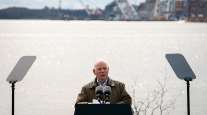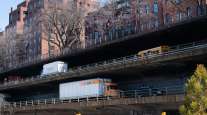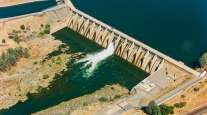Staff Reporter
AASHTO Raises Concerns Over Infrastructure Law Implementation

[Stay on top of transportation news: Get TTNews in your inbox.]
A group representing state highways and transportation sent a 30-page document to Transportation Secretary Pete Buttigieg seeking clarification and recommending actions to help implement the Bipartisan Infrastructure Law.
Shawn Wilson, president of American Association of State Highway and Transportation Officials, wrote to Buttigieg on behalf of key infrastructure owners and operators throughout the U.S. who will be implementing the legislation. AASHTO represents state departments of transportation in 50 states, the District of Columbia and Puerto Rico.
AASHTO’s input is critical at the start of BIL implementation and over the five-year duration of the legislation, including developing regulations, guidance and policies, noted Wilson, also secretary of the Louisiana Department of Transportation and Development.

Wilson
“Where a range of possible legislative interpretations exist, the USDOT should provide interpretations that allow each state to best meet its unique needs,” he noted in the two-page letter and 28-page document, sent April 1, to provide Buttigieg and DOT operating administrations with implementation recommendations and questions.
Wilson acknowledged the historic federal infrastructure investment, with $567 billion in Highway Trust Fund and General Fund resources for DOT and “a unique $113 billion in advance General Fund appropriations for various forms of infrastructure — including transportation —above and beyond authorization and funding of federal trust fund programs.”
“We appreciate these advanced appropriations that provide additional guaranteed funding” to revamp and modernize all U.S. infrastructure asset classes, including federal highway, highway safety, transit and rail programs for fiscal years 2022 to 2026, he added.
He enclosed the document with AASHTO implementation recommendations. The paper outlined topics from funding, safety and bridge and electric vehicle formulas to rail transportation and workforce development. It also addressed several statutory sections of the 1,039-page BIL.
The paper cited different financial management challenges for state DOTs grappling with a mix of new and existing infrastructure programs under different budgetary authorities. AASHTO asked USDOT to work with state DOTs to make these “colors of money” as easy to administer as possible.
For the Bridge Investment Program, it noted that application evaluation should be clearer, especially for bridges at risk of falling into poor condition within the next three years.
“In general, the criteria and selection process should provide flexibility when funding projects for bridges that are ‘transitioning’ from fair to poor classification to maximize funding for both programs,” it stated.
State & local governments are being provided significant resources to improve safety for highway workers & other pedestrians under the Bipartisan Infrastructure Law. #InfrastructureLaw #NWZAW https://t.co/yzLmY8M1DO pic.twitter.com/By7FkEGynG — Federal Highway Admn (@USDOTFHWA) April 12, 2022
It also noted data disconnects between what DOT wants vs. what states collect. For example, DOT’s desire for regionwide load and traffic information on bridges is problematic because statistics are gathered for individual bridges, not regionally. Also, grants will be allocated based on data some states lack (such as total person miles traveled over poor bridges).
“States can potentially start collecting this data, but having consistent and reliable information nationwide is unlikely to exist today, as this is not bridge data that is currently collected and reported, and integrating this data into project selection may take some time,” AASHTO reported.
Another area of concern was in federal carbon-reduction program requirements. Some state DOTs have unclear roles in the future since they lack carbon-reduction authority because it is granted to state environmental protection agencies.

Host Michael Freeze discusses the future of tire maintenance with Yokohama's Tom Clauer and Goodyear's Austin Crayne and Jessica Julian. Hear a snippet above, and get the full program by going to RoadSigns.TTNews.com.
Questions were asked about the Congestion Relief Program, which establishes a new discretionary grant to relieve congestion in metropolitan areas with populations of at least 1 million.
“While not specifically mentioned in this section, urban areas with large truck volumes experience significant congestion issues, so provisions to address this issue should be made, as these resources could significantly improve both safety and operational performance,” AASHTO suggested.
It also mentioned that rural areas in states are excluded despite having congestion mostly along interstates and at freight bottlenecks that DOT should consider. “Height and weight restrictions force trucks onto alternative routes,” it noted.
Another important topic involved the Buy America preference, which AASHTO predicted could slow down BIL implementation dramatically if not phased in. If the mandate is applied to all iron, steel, manufactured products or construction materials, “it will take years before everything is domestically available,” it added.
Want more news? Listen to today's daily briefing above or go here for more info
AASHTO listed other problems. It wondered when Buy America requirements would take effect since there is no federal definition on “all manufacturing processes.” It advised the Federal Highway Administration to help define such processes for construction materials.
Agencies will need time to transition/expand processes to require Buy America certification of compliance. Also, if the existing nationwide waiver is discontinued, FHWA should pursue an updated waiver instead of requiring individual waivers for specific manufactured products, AASHTO added.
“State DOTs strongly support the policy goals of Buy America, which strengthen domestic industries vital to improving our nation’s transportation infrastructure all the while supporting family-wage jobs,” it declared, while noting the provision will be a headache for electric vehicle implementation.
“There must be a pragmatic application of Buy America requirements to the EV infrastructure industry to ensure that deployment doesn’t come to a halt,” AASHTO noted.
Challenges are technical and logistical, including having adequate electrical grid capacity to meet a sudden increase in demand for EV supply equipment as well as having to coordinate with nontraditional stakeholders with existing business models and supply chains.




